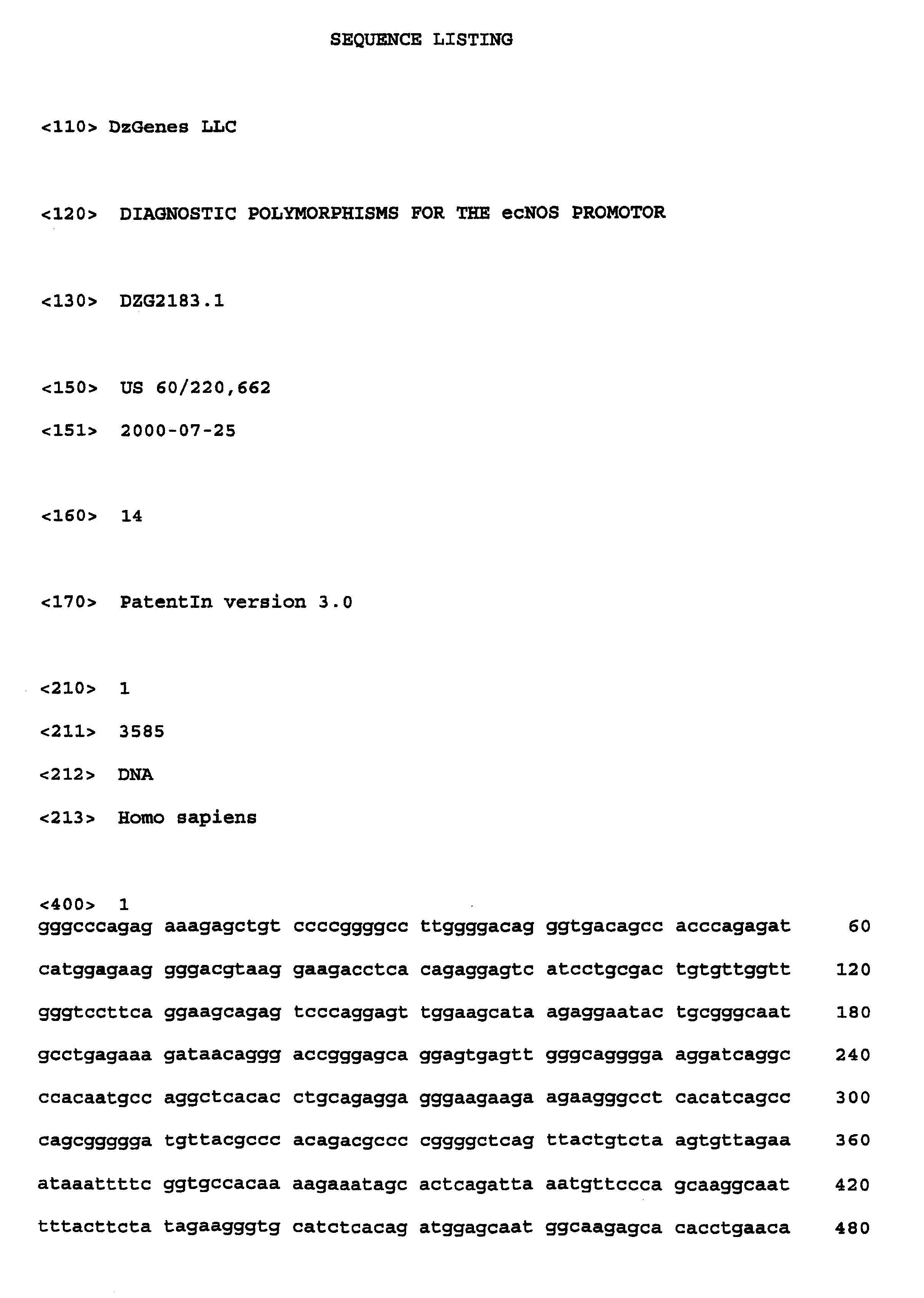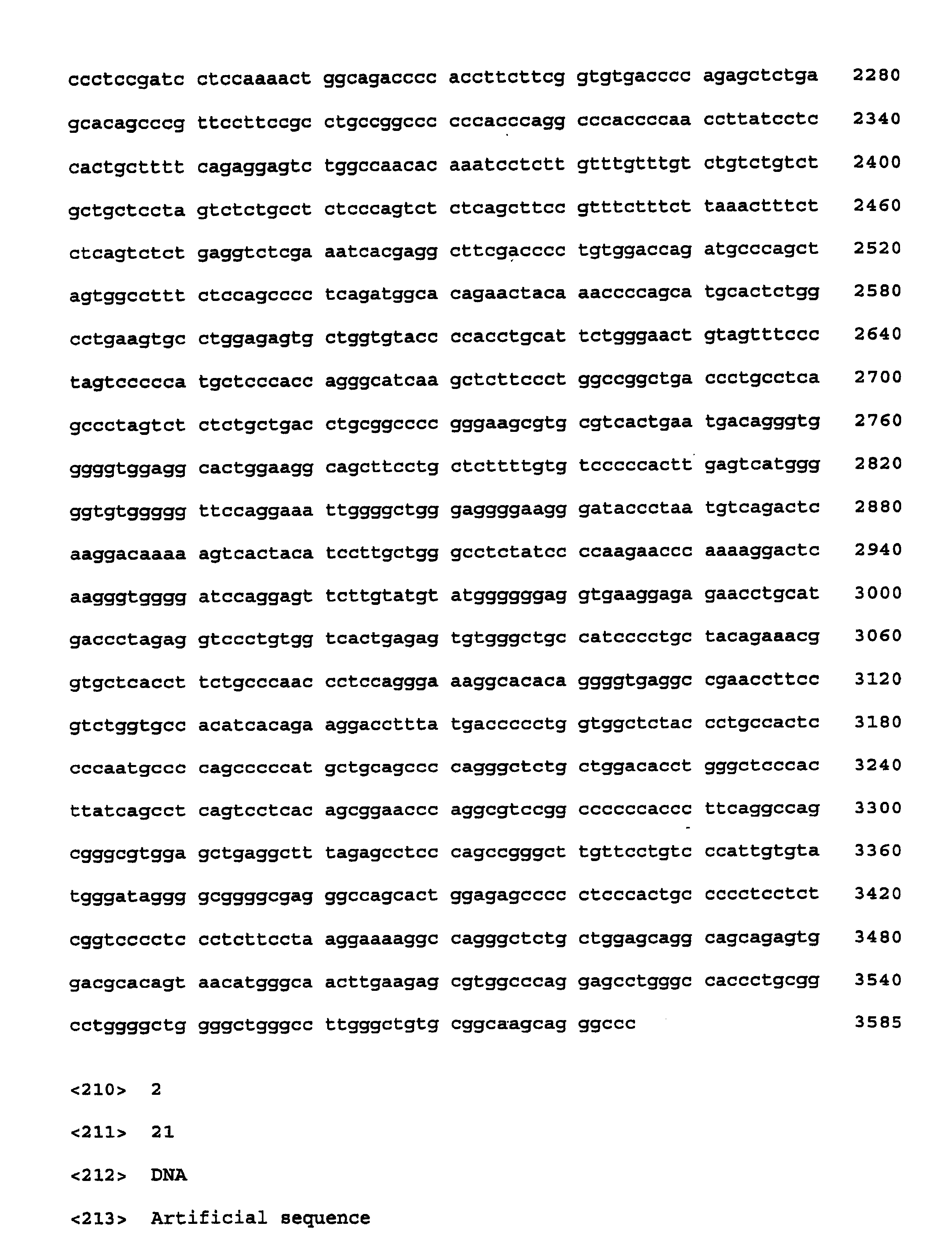Diagnostic polymorphisms for the ecnos promoter
a polymorphism and promoter technology, applied in the field of diagnostic polymorphisms for the ecnos promoter, can solve the problems of individual more susceptible to the condition, production of a protein that is non-functional or has decreased function, and limited rflp analysis of the snps
- Summary
- Abstract
- Description
- Claims
- Application Information
AI Technical Summary
Benefits of technology
Problems solved by technology
Method used
Image
Examples
example 1
Amplification of ecNOS Promoter Genomic DNA
[0109] Leukocytes were obtained from human whole blood collected with EDTA as an anticoagulant. Blood was obtained from a group of black men, black women, white men, and white women without any known disease. Blood was also obtained from individuals breast cancer, lung cancer, prostate cancer, NIDDM, ESRD due to NIDDM, HTN, ESRD due to HTN, myocardial infarction, colon cancer, ASPVD due to HTN, CVA due to HTN, cataracts due to HTN, HTN CM, MI due to HTN, ASPVD due to NIDDM, CVA due to NIDDM, ischemic CM, ischemic CM with NIDDM, MI due to NIDDM, afib without valvular disease, alcohol abuse, anxiety, asthma, COPD, cholecystectomy, DJD, ESRD and frequent de-clots, ESRD due to FSGS, ESRD due to IDDM, or seizure disorder as indicated in the tables below.
[0110] Genomic DNA was purified from the collected leukocytes using standard protocols well known to those of ordinary skill in the art of molecular biology (Ausubel et al., Short Protocols in ...
example 2
G to A Transition at Position 2548 of Human ecNOS Promoter
[0119]
TABLE 1ALLELE FREQUENCIES FOR GROUP I DISEASESGACONTROLBlack men (n = 84 chromosomes)10 (12%)74 (88%)Black women (n = 74 chromosomes)18 (24%)56 (76%)White men (n = 88 chromosomes)31 (35%)57 (65%)White women (n = 106 chromosomes)35 (34%)71 (66%)DISEASEBREAST CANCERBlack women (n = 40 chromosomes) 7 (18%)33 (82%)White women (n = 38 chromosomes)12 (32%)26 (68%)LUNG CANCERBlack men (n = 40 chromosomes) 5 (13%)35 (87%)Black women (n = 32 chromosomes) 6 (19%)26 (81%)White men (n = 40 chromosomes)17 (43%)23 (57%)White women (n = 22 chromosomes) 8 (36%)14 (64%)PROSTATE CANCERBlack men (n = 40 chromosomes)12 (30%)28 (70%)White men (n = 40 chromosomes)18 (45%)22 (55%)NIDDMBlack men (n = 4 chromosomes) 1 (25%) 3 (75%)Black women (n = 6 chromosomes) 1 (17%) 5 (83%)White men (n = 8 chromosomes) 0 (0%) 8 (100%)White women (n = 20 chromosomes) 5 (25%)15 (75%)ESRD due to NIDDMBlack men (n = 12 chromosomes) 1 (8%)11 (92%)Black women (n...
example 3
C to T Transition at Position 2684 of Human ecNOS Promoter
[0176]
TABLE 9ALLELE FREQUENCIES FOR GROUP I DISEASESCTCONTROLBlack men (n = 84 chromosomes)10 (12%)74 (88%)Black women (n = 74 chromosomes)18 (24%)56 (76%)White men (n = 76 chromosomes)29 (38%)47 (62%)White women (n = 94 chromosomes)29 (31%)65 (69%)DISEASEBREAST CANCERBlack women (n = 40 chromosomes) 7 (18%)33 (82%)White women (n = 38 chromosomes)12 (32%)26 (68%)LUNG CANCERBlack men (n = 40 chromosomes)21 (53%)19 (48%)Black women (n = 32 chromosomes) 6 (19%)26 (81%)White men (n = 40 chromosomes)17 (43%)23 (58%)White women (n = 22 chromosomes) 8 (36%)14 (64%)PROSTATE CANCERBlack men (n = 40 chromosomes) 9 (23%)31 (77%)White men (n = 38 chromosomes)17 (45%)21 (55%)NIDDMBlack men (n = 4 chromosomes) 1 (25%) 3 (75%)Black women (n = 6 chromosomes) 3 (50%) 3 (50%)White men (n = 8 chromosomes) 0 (0%) 8 (100%)White women (n = 18 chromosomes)14 (78%) 4 (22%)ESRD due to NIDDMBlack men (n = 12 chromosomes) 1 (8%)11 (92%)Black women (n ...
PUM
| Property | Measurement | Unit |
|---|---|---|
| Fraction | aaaaa | aaaaa |
| Fraction | aaaaa | aaaaa |
| Fraction | aaaaa | aaaaa |
Abstract
Description
Claims
Application Information
 Login to View More
Login to View More - R&D
- Intellectual Property
- Life Sciences
- Materials
- Tech Scout
- Unparalleled Data Quality
- Higher Quality Content
- 60% Fewer Hallucinations
Browse by: Latest US Patents, China's latest patents, Technical Efficacy Thesaurus, Application Domain, Technology Topic, Popular Technical Reports.
© 2025 PatSnap. All rights reserved.Legal|Privacy policy|Modern Slavery Act Transparency Statement|Sitemap|About US| Contact US: help@patsnap.com



